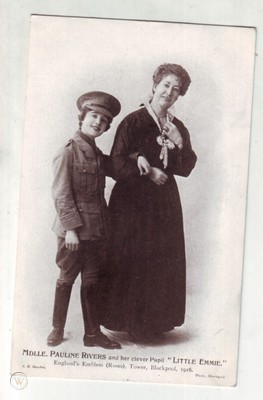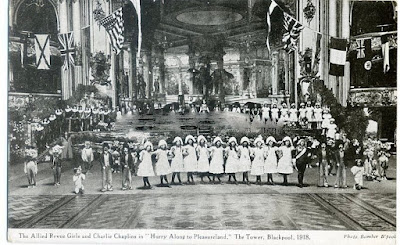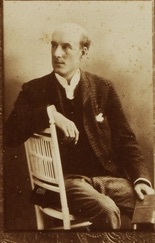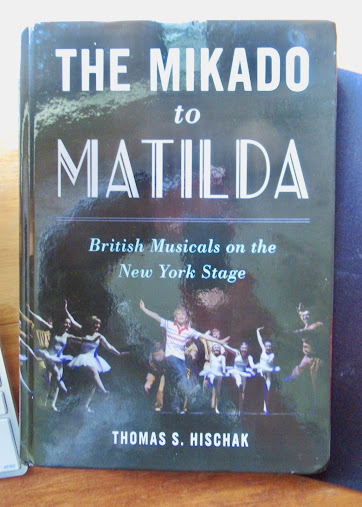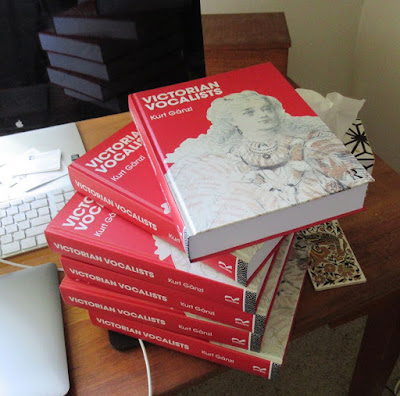I have a tidy supply of home-made nineteenth-century musical theatre biographies, the ones that didn't go into Victorian Vocalists, bursting the seams of my Dropbox. Tales of singers who shone on the international operatic stage and tales of lads and lassies who sang only in provincial concerts. The whole spectrum. Well, one end of the rainbow without the other is not much good when you are looking at the whole world of Victorian music, is it.
More and more often, these days, I find myself dipping into Dropbox, and pulling out a plum or two, whether as a contribution to a book, a journal, a website, or even someone asking 'my great-grandmother was a singer, do you know anything about her?'. Often, I do, and it is great fun to be able to help out with a wee (or not so wee) biog.
This month I've been particularly plum-pullish. My Marion Burton zhooshed off to Theatre Heritage Australia to follow my Blanche Reives, Henry Wharton, Clara Merivale et al into the next issue of their on-line magazine, and today I got a request for ... Alice Barth! So, off she flew, and I thought well, while she's sitting on the desktop, why not share her with the world? So here is the tale of Alice ... a durable and effective Victorian vocalist
BARTH, Alice [Mary] (b 7 Eversholt Street, St Pancras 25 August 1848; d 35 Delancey St, St Pancras 18 July 1910)
Alice Barth was born in London, in 1848, the youngest of the surviving daughters of a gentleman by the name of George Harman Barth (b Hatton Garden, 27 January 1807; d 8 Cambridge Villas, Hammersmith, 9 September 1869) and his wife, Sarah Jane née Wheeler (1812-1870). Mr Barth was something of a curiosity. He had started life as a perfumer but, in the 1851 census, from a home in Mornington Crescent, he lists himself as being a ‘mesmerist’ and, sure enough, the occupants of his home include two youngish ladies of independent means who are his ‘patients’. Hmmm. But Mr Barth progressed from mesmerism into the treatment of maladies by the use of undefined ‘gases’, and in 1854 he patented ‘improvements in an apparatus for administering and supplying and purifying gases or vapours for medicinal and other purposes’. He described himself now as an ‘operative chymist and lecturer’.
Mr Barth’s two youngest daughters, Kate and Alice, both studied singing under Lucy Fosbroke RAM, and it was under her aegis that they made there first appearances as concert singers: I spot them 28 January 1869 singing in the concert given by Mr Hoyte (organist of All Saints, Margaret Street) at Myddelton Hall, in the company of their teacher, and, again, at Miss Fosbroke’s own concert of 24 May where Alice gave Ganz’s ‘Since Yesterday’ and joined her elder sister in the duet ‘The Fan’, alongside Susanna Cole, Fanny Poole and the like. ‘They were rewarded with an amount of applause that must have been very encouraging to them’. However, the sister act was not to be. The following year Kate married Mr John Finch, an upholsterer, of Flora Villas, Chelsea, and retired to a very brief married life ended, seemingly, in 1872, by childbirth.
Alice lost her teacher as well, when poor Miss Fosbroke also died, at the age of just 34, in December of 1870. Which may explain why, when obituary time came eventually around, Alice Barth’s singing teachers were listed as Randegger, Thorpe Pede and Sidney Naylor. Well, Randegger perhaps, but Miss Fosbroke had laid the basics. It does seem – and I am only guessing here, but the coincidence would not be great – that Alice Barth may have owed her first engagement – the one which would set her off on nearly forty years of a career as a vocalist – to her father and her brother-in-law and their colleagues. The brother-in-law in question was William Henry Walenn (1828-1896), another ‘chymist’ and inventor, with a penchant for electricity, which led him to invent and patent a range of articles from an electric aid for rheumatic cures to a system for automatic electric gates. He had married Alice’s sister, Skene Charlotte Barth (b Wolverhampton 1837; d Bryanston Mansions 2 February, 1927), in 1854, and would produce, in addition to the inventions, something like 14 children, of whom a number made themselves a prominent position in the musical world.
Both Barth and Walenn would surely have had connections with the celebrated Royal Polytechnic Institution, London’s most popular outlet for inventive physical and chemical ideas and demonstrations, which had flurished since 1848, under the direction of the charismatic John Henry Pepper (1821-1900), the inventor of the ghost illusion named ‘Pepper’s Ghost’ and the populariser of the spectacular scientific lecture.
At Whitsun 1871 (29 May), Mr Pepper opened a less inventive spectacle than usual, a piece entitled
A Trip to the West Highlands of Ireland, teamed with a new presentation of the songs of Henry Russell ‘with scenic optical and dioramic illustrations’, produced under the aegis of the famous songwriter himself. The popular tenor Joe Plumpton sang the Russell songs, and for the Irish part of the programme, it was Alice who provided Irish ballads. ‘Miss Alice Barth made her debut yesterday and both she and Mr Pepper must have been highly gratified at the reception which she met with. Her voice combines great purity with considerable compass and volume and evinces careful cultivation and good taste; and the audience testified its appreciation by a double encore’ (
Daily News), ‘Several Irish songs were sung by Miss Alice Barth in a manner which elicited loud and well-deserved applause’ (
Morning Post), ‘a voice of good quality and considerable compass’ (
The Era).
Alice became an immediate favourite at the Polytechnic, and she would remain there, both with Pepper and with George Buckland, for more than 18 months, through frequent changes of programme, giving patriotic songs to accompany Pepper’s
The British Army and its Stations (The Battle of Dorking), ballads in
The Story of the Shadowless Man, singing ‘songs and duets ancient and modern’ with Florence Hunter in the ‘pictorial and anecdotical entertainment’
Old and New London, Buckland’s versions of
Undine and
The Sleeping Beauty (singing Reichardt’s ‘The Image of the Rose’), J L King’s lecture on
Jerusalem as it was and is (where she slipped in Gounod’s ‘Ave Maria’) and the illusion show
The Three Roses, or the Invisible Prince in a New Light. Perhaps her most outstanding success came, however, during the illness of the Prince Consort, when each evening Miss Barth – widely advertised – stepped forward to give ‘God Bless the Prince of Wales’ with ‘an electric effect on the audience’.
In between times, Alice also took part in some of the city’s popular concerts, singing alongside such patented artists as Rudersdorff, Liebhart, Edith Wynne, Vernon Rigby and the Pateys, and duetting with Helen D’Alton, as well as visiting spots ranging from Windsor to sing with the Windsor and Eton Choral Society to Margate’s Hall by the Sea during the summer season.
Alice Barth would return, over the years, on many occasions, to the Polytechnic but, in the first days of 1873, she found her career moving decidedly onwards and upwards. She was engaged to take over (4 January) the role of Morgiana in the Gaiety Theatre’s matinees of the burlesque
Ali Baba à la mode. Her singing went down a treat, but the press mused ‘[she is] graceful and refined if not perhaps sufficiently piquant for this class of performance’. On 17 February, Alice entered the evening bill, playing Donna Elvira in
Don Giovanni in Venice, to Nellie Farren’s Leporello. ‘[She] sang creditably and with more experience of the stage will be an acquisition to the company’ came the reaction, but Alice Barth did not persevere (or was not persevered with) at the Gaiety. On 8 May, she opened at the Crystal Palace, again playing Donna Elvira, but not, this time, in burlesque, but in Mozart’s opera, alongside Blanche Cole, Ida Gilliess, F H Celli and Henri Corri. During the Crystal Palace opera season she went on to sing in Satanella, behind Miss Cole, and as Adalgisa to the Norma of Miss Gilliess.
She sang at Rivière’s Covent Garden proms, at Margate again, she sang at the Freemason’s Hall in popular concerts of
The Creation and Rossini’s
Petite Messe Solennelle, and in September she was engaged as co-prima donna, with the young Gertrude Ashton, at a brand new theatre, the Alexandra in Camden Town, where Mr Thorpe Pede had been installed in virtual command.
I have written an article about Mr Thorpe Pede or Peed. Enough said. He is quoted (by himself) as being the singing teacher of both the Misses Ashton and Barth. Miss Ashton (daughter of a fine singing techer) objected firmly in print to the description. Anyhow, Alice left the Gaiety and the Crystal Palace, Covent Garden and the Freemason’s Hall to go to Camden Town, and there she appeared in Pede’s
The Magic Pearl and
In the Clouds, played Georgette in
‘Twas I, and principal boy in the Pede panto of
Mother Redcap until 'his' money ran out and her engagement ended.
During 1874, she appeared again at the Crystal Palace where, in September, she was responsible for the production of a double bill of Offenbach operettas –
Howling Wind (
Vent du Soir) and
Le Rouge et le noir, but on 8 October she retired from the stage to marriage to a Birmingham engineer by the name of Frederick William Usher.
It was, however, to be but a brief retirement. After the birth of her son, Frank, at the beginning of 1876, ‘Madame Barth’ returned to the Polytechnic (the operetta
Courtship Under Difficulties with Buckland), to the concert platform at the Westminster Aquarium, the Freemason’s Hall, to St James’s Hall where she gave ‘Love’s Young Dream’ and ‘Young May Moon’ on St Patrick’s Night, to Rivière’s proms (‘The Harp that Once’), to the Brighton Aquarium – another venue which would become a staple down the years – and, in August 1877, to the Crystal Palace and its opera company. There she repeated her Donna Elvira, sang in
Guy Mannering and as Adina in
L’Elisir d’amore and, on 13 September, took part in the first English-language performance of Mozart’s little
L’Impresario, adapted into English by W Grist as
The Manager. Alice was ‘much applauded for her brilliant rendering of the solo assigned to the high soprano, and in the scene where the young prima donna reveals her jealousy of the other artiste she was sprightly and amusing’ (
Era). In the autumn, she went out of town with the Crystal Palace Company, in December she returned to town singing
Il Matrimonio segreto with them, and then she moved on to a loftier venue. She was hired as one of the young artists who were to feature in an English-language opera season at no less a venue than Her Majesty’s Theatre. During this operatic season, she appeared as Anne Chute to the
Lily of Killarney of Mathilde Bauermeister, and took over suddenly – without rehearsal – the role of Arline in
The Bohemian Girl, when the neophyte Carina Clelland took ill.
It may have seemed, at this moment, that Alice Barth would go on to a good, if not significant, career in English opera, but in the event – for some reason – she chose, for the meanwhile, to go a different way. Between appearances at Brighton, Blackpool, Margate, Windsor and other such venues, in April 1879, Alice Barth sent out a small tour of drawing room operettas: Virginia Gabriel’s
Widows Bewitched and Offenbach’s
Forty Winks (
Une nuit blanche). The experience was obviously a satisfying one, for over the years to come ‘Alice Barth’s Operetta Company’ would become a familiar feature of the southern circuits, with regular London appearances at the Crystal Palace or the Alexandra Palace. The popular
Widows Bewitched would remain the staple of her repertoire, but
The Sleeping Queen (featuring Alice alongside Lucy Franklein, Richard Temple and Gerard Coventry), the Garden Scene from
Faust, with Aynsley Cook as Mephistopheles and Henry Walsham as Faust, Massé’s
Les Noces de Jeannette anglicised as
Haste to the Wedding, and
The Rose of Auvergne all made appearances in her repertoire in 1880.
The operetta company, however, did not tour the whole year round, and Alice took time out to take turns with both Traverner’s and Walsham’s small-scale touring opera companies, to sing at the Covent Garden and Hengler’s proms, an Elijah at Lancaster (1880), and in November 1881 (5 November), in spite of a putative ban on HMS Pinafore being sung in Britain for three years, to sing Josephine at the Alexandra Palace. But, always, she returned to her own little company, and to the drawing room operetta. On 29 August 1881 she joined Buckland again to play a new musical sketch, Cross Purposes, and, when the Polytechnic was announced as closing, it was her company and Widows Bewitched which was brought in to play the closing performances. Their success was such, that, on Xmas Eve, the old place re-opened, and Alice Barth’s Ballad Opera Company was again the attraction.
Soon, they were on the road again – Alice, Kate Leipold, Falkner Leigh and Eric Lewis – producing a new piece, A Storm in a Teacup, at Brighton (18 February 1882) and, such was Alice’s reputation now as a drawing room performer, that when Alfred Reed and Corney Grain made one more attempt to keep ‘Mr and Mrs German Reed’s Entertainment’ afloat at St George’s Hall, it was Alice Barth whom they called in to play Arabella Upshott in The Head of the Poll, alongside Fanny Holland and North Home. A Storm in a Teacup and Widows Bewitched were supplemented by Quid pro Quo, The Chalet, Dr Miracle, A Fair Encounter, The Loan of a Lover and, on occasion, a truncated Trovatore, as the Barth company made its way around Britain in 1882 and into 1883, adding a version of George Fox’s The Captain of the Guard. And then Alice put the company’s shutters up for a while and went off to the Sheffield Theatre Royal, to play and sing ‘Mirth, a good fairy’ in the pantomime, Beauty and the Beast.
Miss Alice Barth clearly had no fixed ideas about genre. She simply played what she wanted to play, and made a success wherever she went, and the year of 1884 is a fine example of this. After panto at Sheffield, she visited London for the Royal Aquarium proms, she sang Wilhelmina in The Waterman in a London Benefit, and then resuscitated her company for the production of a new operetta, This House to Let (Brighton, June 1884). Then, in September, she went back on the road -- as co-prima donna, alongside Blanche Cole, of J S Tanner’s sizeable English Opera Company. She sang Susanna to Miss Cole’s Countess Almaviva, she sang Maritana and sometimes Arline, and, when the company put on The Crown Diamonds, she was Diana to Blanche Cole’s Catarina. Her singing and her ‘piquancy and grace’ were everywhere remarked on, and her acting was very often singled out for special mention.
She carried on through a second tour with the opera company (now managed by Sidney Leslie), and, when it paused, she brought back her own repertoire and, with Joseph Pierpoint, tenor, Michael Dwyer, baritone, Louisa Lyle and Richard Cummings, re-opened at Leamington 9 May 1885 for another operetta tour. The Nabob’s Pickle, Ganymede and Galatea, The Waterman and The Noble Savage strengthened the best of the old repertoire through a goodly tour until (with a small parenthesis for a flop musical The Pet of Newmarket at the Holborn Theatre) she moved on to Worcester to play the pantomime Dick Whittington, and then picked up her place in the newest version of the Leslie opera company. And now she was singing Amina in La Sonnambula.
1887 saw the Alice Barth company again on the road, with Gounod’s La Colomba (The Pet Dove) and Don Pasquale the newest items in the repertoire, but disaster struck in Preston with the death of the company’s principal tenor and Alice’s right-hand man, Joseph Pierpoint. The tour closed down, and soon after Alice joined the forces of Arthur Rousbey’s rising English opera company. Now, she was less seen in such roles as Arline, Maritana and Susanna: when The Marriage of Figaro was staged, Alice Barth sang the Countess, when Il Trovatore was done she now took on the role of Leonora, and if some were heard to whisper that the voice was perhaps not quite hefty enough for those roles, the management of the Carl Rosa was not one. Alice Barth was engaged to appear with this best-known of English opera companies as Mozart’s Countess at the Theatre Royal, Manchester.
But, again, from Rousbey and Rosa, Miss Barth wandered off to lesser things: engagements as prima donna in Edwin Leahy and Calder O’Beirne’s short lived small-dates troupe, and then with the outfit headed by the lady who called herself ‘Ilma Norina’, but it didn’t seem to harm her prospects. In November 1889 when the Norina company and the Carl Rosa collided in Glasgow, Alice Barth was playing, not with the small company, but appearing as Donna Anna to the Zerlina of Zélie de Lussan and the Elvira of Georgina Burns in
Don Giovanni with the grander one! And a month later it was the pantomime,
Beauty and the Beast at Oldham.
During the 1890s, Alice Barth continued her multi-layered career. She sang in concerts in the East End of London, visited Aston Lower Ground in Birmingham regularly to sing with a military band, she visited the Crystal Palace, and took trips out of town to sing prima donna roles with amateurs ... and between all that, she fulfilled a stint with Valentine Smith’s opera company as prima donna (1890), went on the road for a long tour with the Burns and Crotty company singing one of the sisters in Georgina Burns’ star-vehicle
Cinderella, and took guest turns with the Carl Rosa as Donna Anna, the Countess Almaviva, Janet Raistrick in
Jeannie Deans and the Marchioness in
The Daughter of the Regiment, before returning to Rousbey to play the juvenile lead, Marie, in the same opera. And there was still time to pop off to the Tyne Theatre, Newcastle, to play the Baroness in yet another version of
Cinderella.
And then, in 1895, Alice Barth’s career took one more and definitive turning. The rise of the so-called ‘musical comedy’ during the 1890s, had seen the touring circuits flooded with examples of the ‘new genre’. Now the combined singing and acting talents of Alice Barth found a fine playground for their expression as she went on the road playing the role of Mrs Honeycombe in the very long tour of the hit musical
The Gay Parisienne (1895). Her success was such that she was soon hired to play a similar role in London, and in 1897 she succeeded Kate Talby, at Terry’s Theatre, as Lady Hawser in what would be another exceptionally long running piece,
The French Maid. Alice Barth had become a classic ‘komische Alte’, a comedy singing character lady. Over the years that followed, she was seen in
Big Claus and Little Claus, Her Royal Highness, Skipped by the Light of the Moon (1899, Mrs Dingle),
Little Hans Andersen and, most particularly, in repeated seasons of the seasonal
Alice in Wonderland in which she played the dual role of the Duchess and the Red Queen. In 1907 (2 March) she took the role of Lady Heldon in the Seymour Hicks production of
My Darling at the Hicks Theatre.
During these years, however, Alice Barth did not neglect the kind of music in which she had made her success. In 1897, she took on the management of a season of operatic concerts at the new Wembley Park pleasure garden, and, from 1900, for six consecutive seasons produced and directed the musical recitals at the Victoria Hall, Waterloo Road.
My Darling and the seasonal production of
Alice in Wonderland of 1907-8 marked the end of Alice Barth’s career as a performer, and she died two years later.
Her husband, Usher, had died in 1889, and it was said that she had subsequently married the actor and vocalist known as F(rank William) Campbell Bishop, some years her junior. However, they must have popped over the border to tie the knot, for I can find no record of this. And Alice died as the widow Usher.
I have no idea what became of Alice’s son, Frank Usher, but music certainly stayed afloat in the Barth family, well into the twentieth century, thanks to the work of sister Charlotte’s children. Dorothea (1875-1948) violin teacher at the RAM, Arthur Julius Walenn (1861-1937), baritone vocalist and RAM professor; Gerald Harman Walenn (1871-1942) violinist and teacher, latterly in Australia; and Herbert Gregor Walenn (1870-1953), the celebrated ’cello player and professor, all made careers in music, but the most memorable theatrical contribution was made by son Charles Rovy Walenn (b Islington 2 July 1867; d Hendon 30 May 1948), a leading player with the Savoy Theatre/D’Oyly Carte Gilbert and Sullivan companies for decades, through nearly half a century on the West End stage.
And elder son, James Farquharson Walenn (b Jan 1860; d 10 Feb 1884) organist and composer, died at a young age, while Frederick Dudley Walenn (d London 10 April 1933) became a painter and Principal of the St John’s Wood School of Art.
















